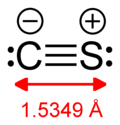Carbon-oxygen compounds
There are many oxides of carbon (oxocarbons), of which the most common are carbon dioxide (CO2) and carbon monoxide (CO). Other less known oxides include carbon suboxide (C3O2) and mellitic anhydride (C12O9). [5] There are also numerous unstable or elusive oxides, such as dicarbon monoxide (C2O), oxalic anhydride (C2O4), and carbon trioxide (CO3).
There are several oxocarbon anions, negative ions that consist solely of oxygen and carbon. The most common are the carbonate (CO32−) and oxalate (C2O42−). The corresponding acids are the highly unstable carbonic acid (H2CO3) and the quite stable oxalic acid (H2C2O4), respectively. These anions can be partially deprotonated to give the bicarbonate (HCO3−) and hydrogenoxalate (HC2O4−). Other more exotic carbon–oxygen anions exist, such as acetylenedicarboxylate (O2C–C≡C–CO22−), mellitate (C12O96−), squarate (C4O42−), and rhodizonate (C6O62−). The anhydrides of some of these acids are oxides of carbon; carbon dioxide, for instance, can be seen as the anhydride of carbonic acid.
Some important carbonates are Ag2CO3, BaCO3, CaCO3, CdCO3, Ce2(CO3)3, CoCO3, Cs2CO3, CuCO3, FeCO3, K2CO3, La2(CO3)3, Li2CO3, MgCO3, MnCO3, (NH4)2CO3, Na2CO3, NiCO3, PbCO3, SrCO3, and ZnCO3.
The most important bicarbonates include NH4HCO3, Ca(HCO3)2, KHCO3, and NaHCO3.
The most important oxalates include Ag2C2O4, BaC2O4, CaC2O4, Ce2(C2O4)3, K2C2O4, and Na2C2O4.
Carbonyls are coordination complexes between transition metals and carbonyl ligands. Metal carbonyls are complexes that are formed with the neutral ligand CO. These complexes are covalent. Here is a list of some carbonyls: Cr(CO)6, Co2(CO)8, Fe(CO)5, Mn2(CO)10, Mo(CO)6, Ni(CO)4, W(CO)6.





